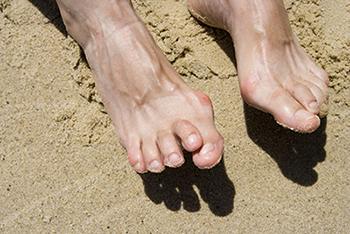If you’re one of the over 60 million worldwide affected by hammertoe, we can help. At our Island Foot Clinic locations we can provide you with a customized treatment plan to correct this condition, restore a normal appearance to your foot, alleviate your symptoms, and restore your quality of life.
Causes, Symptoms, and Treatment Options for Hammertoe
Hammertoe is a condition in which the toe joint bends and resembles a hammer. It affects millions of individuals worldwide and is a primary reason for almost fifty percent of foot surgeries. This foot condition is also called a claw toe and can affect one or more of the toes, typically the second, third, or fourth.
Regardless of what caused it and how many symptoms you’re dealing with, it’s important that you seek out professional treatment to receive an official diagnosis, so you can move forward with the right treatment plan.
The Causes
Hammertoe is most prevalent in older patients, specifically those with bunions, high arches, or very flat feet. On average, women are more likely to develop this condition, but it also affects many men. Patients suffering from arthritis and diabetes are also more prone to this condition. Genetics, poor-fitting shoes, arthritis, and biochemical or muscle and balances can all contribute to the development of this joint deformity.
Genetics
This particular joint deformity is often the result of genetic predisposition. The natural shape and structure of your foot, combined with other lifestyle factors, can increase your chances of this joint deformity. If your parents suffered from joint deformity of the toes, you have an increased risk of also developing this condition.
Poorly-Fitting Shoes
Another cause for this common joint deformity of the toe is ill-fitting shoes. Shoes that are too tight and put extra stress on your joints or force your toes to bend in an unnatural position for too long can lead to joint deformity. Certain types of footwear, specifically high heels, elevate the foot and essentially force the toe into an unnatural position. Wearing these kinds of shoes frequently or for hours on end can contribute to a toe deformity.
Arthritis
Patients suffering from arthritis are more prone to developing this foot condition, since arthritis essentially causes the joints to break down over time. As the joints grow weaker, the toes can begin to bend and take on that unnatural hammer position.
Biochemical or Muscular Imbalances
In many cases, the cause of this condition stems from a biochemical or muscular imbalance. Imbalanced muscles contract, thereby affecting the underlying bone structure within the foot. As a result, the toe joint gradually loses flexibility, grows rigid, causes pain and discomfort, and even reduces mobility.
The Symptoms
There are many different symptoms associated with hammertoe. For some, the symptoms are mild, while for others, they’re more severe. Regardless of the severity of your symptoms, it’s important that you seek professional treatment at the first sign of these symptoms because the earlier the condition is diagnosed, the easier it is to treat without surgical intervention.
Several symptoms can help you identify the condition. If you’re still unsure whether your joint issue is hammertoe, we can help. When you schedule an appointment with one of our podiatrists, they can evaluate your affected toe or toes, diagnose the issue, and then provide you with a treatment plan that’s right for you.
Pain
Patients with this toe deformity often experience pain and discomfort, typically at the top of the bent joint. However, pain can also radiate from the bottom of the foot.
Corns and Calluses
Patients with this condition are more prone to corns and calluses on the bottom of the toe as the deformed joint can change how you walk, re-distributing your weight and putting pressure on different areas of the foot, causing corns and calluses to form.
Stiffness
Another sign of this foot condition is stiffness. If you notice that one or more joints on your second, third, or fourth toes are becoming progressively stiffer and less mobile, a retracted toe joint may be the cause.
Visible Deformity
One of the telltale signs of this condition is visual deformity. The joint will bend upwards, and the toe will eventually resemble the hammer, after which the condition is named.
Inflammation and Swelling
Swelling and inflammation are other symptoms that result from joint rigidity and deformity, which can also cause discomfort and affect mobility.
Reduced Mobility
In the early stages of hammertoe, the affected toe may cause some discomfort but may not affect mobility. Yet, for some, it will interfere with the ability to walk naturally and comfortably.
Diagnosing Your Condition and Designing Your Treatment Plan
We design customized treatment plans for each patient suffering from this condition at our Island Foot Clinic locations, including our Victoria, BC, and Kelowna, BC offices. Treatment options range from at-home solutions and custom orthotics to surgical procedures, depending on the severity of the condition.
To design a treatment plan, we must diagnose the joint deformity, evaluate the condition of your toe or toes during a physical examination, and learn more about your symptoms. During the diagnosis process, we will perform a physical examination of your foot and may request an X-ray, CT, MRI, bone scan, or other imaging studies as needed to get more insight into your condition, so we can move forward with the proper treatment plan.
At-Home Treatment Options
Minor to moderate cases can be treated at home with functional orthotics and homeopathic remedies. To relieve pain, you can soak your foot in lukewarm water or apply a cold compress to the area to reduce inflammation, swelling, and discomfort.
Avoiding shoes that force the toes into an unnatural or bent position for long periods will also help treat the affected joint, as will wearing supportive shoes with a deep toe box that allows plenty of space for the toes to extend naturally.
Custom Orthotics
We can also perform trimming and padding and prescribe a custom orthotic that you can wear to realign the bones and reduce joint pressure to straighten the toe, alleviate symptoms, and prevent future deformity.
Surgical Treatment Options
For more severe cases, surgical treatment may be necessary. If you’ve tried at-home treatments, orthotics, and other homeopathic and alternative methods to treat this condition but haven’t been successful, you may need to undergo a surgical procedure to correct the joint deformity. If you’re a good candidate for a surgical procedure, we’ll review all of the details with you at your consultation so that you’re prepared for the surgery and the recovery process.
Am I a Candidate for Hammertoe Treatment in Victoria, BC, or Kelowna, BC?
Whether you’re suffering from a minor, moderate, or more severe case of hammertoe affecting the appearance of your foot, mobility, or quality of life, you may be a good candidate for a customized treatment plan.
The first step in the process is an initial consultation, during which we’ll meet with you to diagnose the condition and then recommend the right treatment plan. Our goal is to restore your mobility, decrease your pain, and resolve this condition once and for all.
Schedule Your Consultation Today
If you live in the Victoria, BC, or Kelowna, BC, area and are interested in learning more about our treatment options, we can schedule a consultation to meet with you, answer any questions, and design your treatment plan. Contact us today at one of our Island Foot Clinic locations to learn more and to schedule your appointment.

